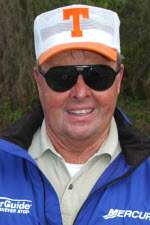
I have spent nearly my entire fishing career peering out beneath the bill of this “T” cap. And no, that is not why they call me Bill.
But it is true, the cap, which began as a lucky streak and became a signature of sort, also holds method to the madness. In short, I can see better while wearing it because my eyes are shaded.
Of course, there has long been a misconception that light hurts the eyes of bass. This is a logical assumption, most likely following the belief that bass bite better in the low-light periods of early morning, late afternoon or on cloudy days.
But actually, I and many other anglers have experienced phenomenal bass fishing at midday when it was very sunny. The sun does not intimidate, cause a negative response or hurt the eyes of bass. In fact, there is a black pigment in the eyes of bass that shades the photo sensory cells of the retina.
The reality is bass like to hang out in shade, partly because it provides them cover to hide in, but mostly because it helps them see well.
Like the aforementioned bill on a cap, a visor in your automobile or simply shielding your eyes with your palm while looking across a sunlit field, shade helps us see better, too.
Think of what bass see in shade as opposed to light in this way: One night you step outside your home and look back in the lighted window. It’s easy to see everything through the window. The next day you go outside at midday and look into the window again: You can’t see inside the house nearly as well.
This is what bass have going on when they lurk in the shade. They see better.
Of course, there are several shady patches to consider. Overhanging shoreline trees, docks, etc., provide shade, as do laydowns, logs and trees standing in the water. And these can provide shade at all times of the day, with the location of where it falls depending on the angle of the sun.
I remember once, when I began fishing a line of shade cast on the water by shoreline trees, bass were all along this shade line, and I got all my strikes within 2 to 3 feet of where the light and dark patches met.
I fished (holding the boat in the sun and casting into the shade) all along this line for 200 yards or so and then did a U-turn and went back. The fish remained on the shade line. And though the angle of the rising sun caused it to move in toward the bank, the fish simply moved with it, until the shade line fell on water too shallow to hold bass.
That’s just one example of how bass like and seek out the shade.
The question now might be how to approach and fish it. Most anglers are going to tell you to cast beyond it and work your lure into, or near, the shady patch. If this fails, you will have to experiment and let the mood of the fish show you the best method of retrieve.
Regardless, it’s a good bet bass are going to be found in the shade where they can see and ambush prey better. And with that in mind, it’s also a place where a smart angler should cast his lure.
For more words of wit and wisdom from one of our sport’s greatest legends, check out www.billdanceoutdoors.com.

